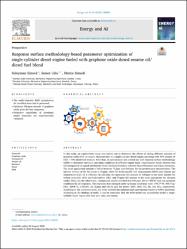| dc.contributor.author | Şimsek, Süleyman | |
| dc.contributor.author | Uslu, Samet | |
| dc.contributor.author | Şimşek, Hatice | |
| dc.date.accessioned | 2023-04-20T08:05:59Z | |
| dc.date.available | 2023-04-20T08:05:59Z | |
| dc.date.issued | 2022 | |
| dc.identifier.issn | 2666-5468 | |
| dc.identifier.uri | https://doi.org/10.1016/j.egyai.2022.100200 | |
| dc.identifier.uri | https://hdl.handle.net/20.500.11776/11150 | |
| dc.description.abstract | In this study, an experimental study was carried out to determine the effects of adding different amounts of graphene oxide (GO) on engine characteristics to a single-cylinder diesel engine operating with 30% sesame oil (SO) + 70% diesel fuel mixture. After that, an optimization was carried out with response surface methodology (RSM) to determine optimum operating conditions at different engine loads. Experimental results showed that GO nanoparticle is a good addition for diesel–biodiesel blends to enhance the performance and reduce emissions. The most appropriate amount of GO is between 75 ppm and 100 ppm for the performance characteristics. The optimal amount of GO for power is 75 ppm, while for brake-specific fuel consumption (BSFC) and exhaust gas temperature (EGT) it is 100 ppm. In addition, the maximum GO amount of 100 ppm is the most suitable for carbon monoxide (CO) and hydrocarbon (HC), and 75 ppm GO amount is the most appropriate for nitrogen oxides (NOx). On the other hand, optimization results revealed that 100 ppm GO at 1950 W load was optimum conditions for all responses. The responses that emerged under optimum conditions were 1746.77 W, 968.73 g/kWh, 259.8 ?C, 0.0603%, 23.13 ppm and 185.61 ppm for power, BSFC, EGT, CO, HC, and NOx, respectively. According to the validation study, the error between the optimum and experimental results is 4.69% maximum. According to the findings of study, it can be concluded that the RSM model can successfully model a single-cylinder diesel engine and thus save time, and money. © 2022 | en_US |
| dc.description.sponsorship | No financial support was received from any institution or organization for this study. | en_US |
| dc.language.iso | eng | en_US |
| dc.publisher | Elsevier B.V. | en_US |
| dc.identifier.doi | 10.1016/j.egyai.2022.100200 | |
| dc.rights | info:eu-repo/semantics/openAccess | en_US |
| dc.subject | Biodiesel | en_US |
| dc.subject | Diesel | en_US |
| dc.subject | Graphene oxide | en_US |
| dc.subject | Nanoparticle | en_US |
| dc.subject | RSM | en_US |
| dc.subject | Sesame oil | en_US |
| dc.title | Response surface methodology-based parameter optimization of single-cylinder diesel engine fueled with graphene oxide dosed sesame oil/diesel fuel blend | en_US |
| dc.type | article | en_US |
| dc.relation.ispartof | Energy and AI | en_US |
| dc.department | Meslek Yüksekokulları, Teknik Bilimler Meslek Yüksekokulu, Makine ve Metal Teknolojileri Bölümü | en_US |
| dc.identifier.volume | 10 | en_US |
| dc.institutionauthor | Şimşek, Hatice | |
| dc.relation.publicationcategory | Makale - Uluslararası Hakemli Dergi - Kurum Öğretim Elemanı | en_US |
| dc.authorscopusid | 57204216513 | |
| dc.authorscopusid | 57203723320 | |
| dc.authorscopusid | 57223897850 | |
| dc.identifier.scopus | 2-s2.0-85137616973 | en_US |



















